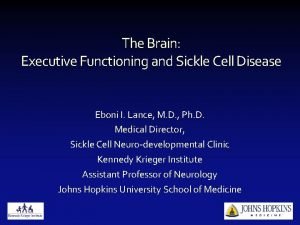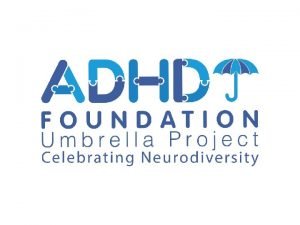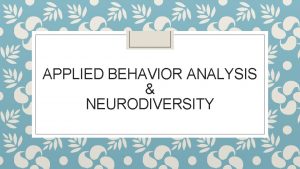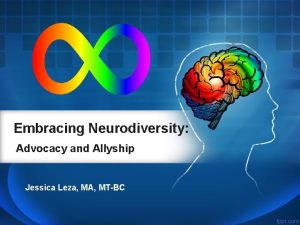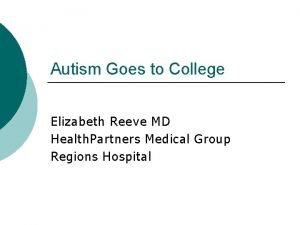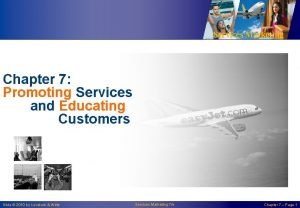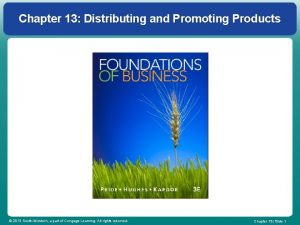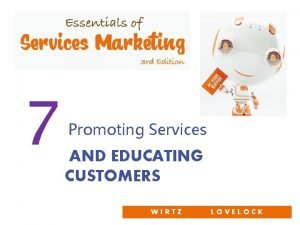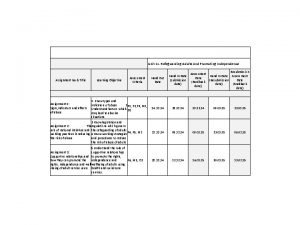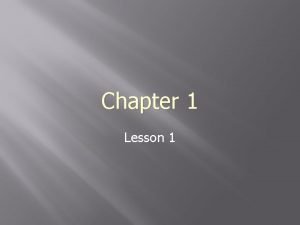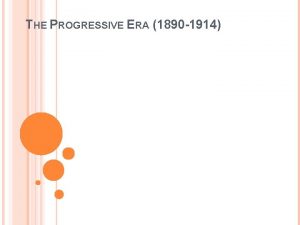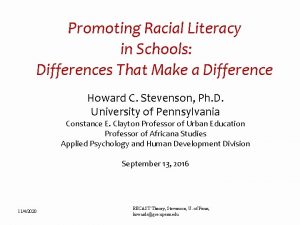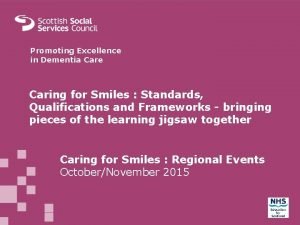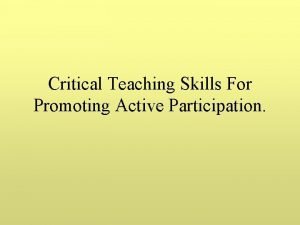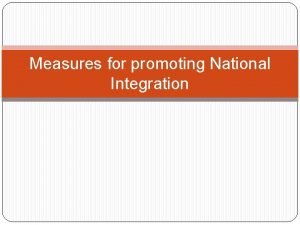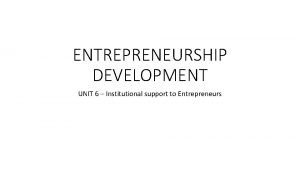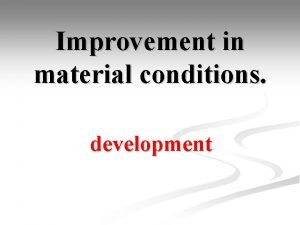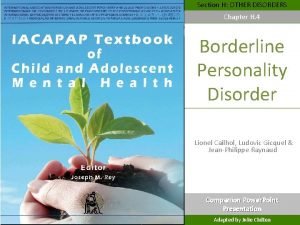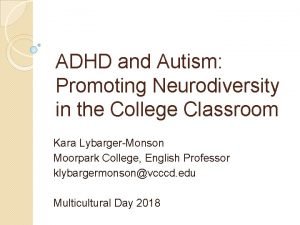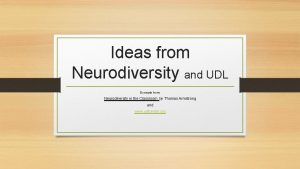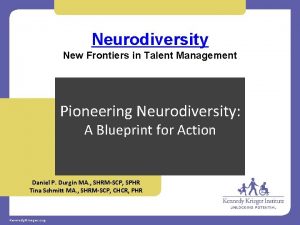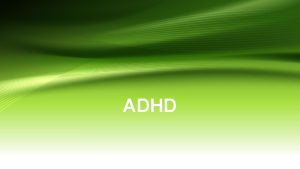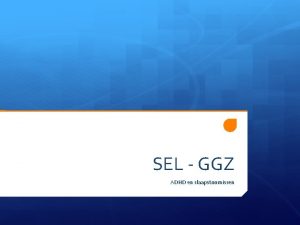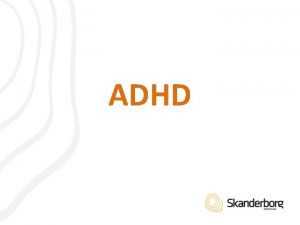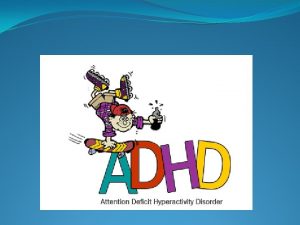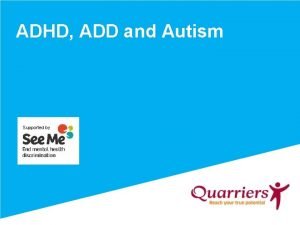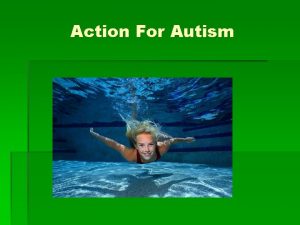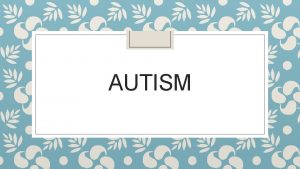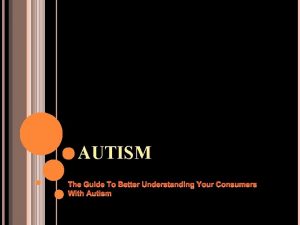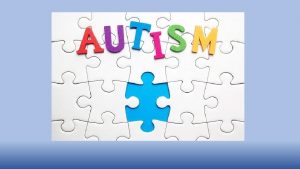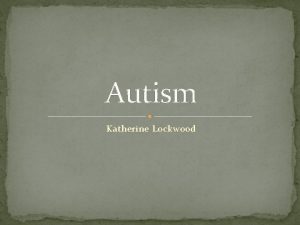ADHD and Autism Promoting Neurodiversity in the College






























- Slides: 30

ADHD and Autism: Promoting Neurodiversity in the College Classroom Kara Lybarger-Monson Moorpark College, English Professor klybargermonson@vcccd. edu Multicultural Day 2018

Background �ADHD and ASD are neurological disorders �Research shows that the disorders have 50% genetic and 50% environmental causes �The rates are on the rise �They impact individuals across ALL gender, racial, ethnic, and socioeconomic backgrounds �They have a high rate of coexisting conditions �Every person is absolutely unique

A Case for Neurodiversity is the idea that having individuals with autism, ADHD, and other neurological disorders in the classroom and workplace is an advantage and contributes to diversity initiatives and inclusionary practices.

Article in Harvard Business Review Gary P. Pisano of Harvard Business School “Their intellectual horsepower is quite high. They do things differently and they behave differently, but the question is, can you turn that into a virtue? That’s part of the thinking on this idea of neurodiversity; that we do better when we mix people who think differently or are wired a bit differently” (qtd. in Holland).

The Spectrum of Success Promote neurodiversity and ensure equity: • Use effective instruction strategies • Address different learning styles • Increase one’s general understanding of these neurological disorders

Rising Rates of ADHD and ASD �ADHD diagnosis has increased: ◦ 7. 8% in 2003 ◦ 9. 5% in 2007 ◦ 11. 0% in 2012 �ASD diagnosis has increased: ◦ One in 150 in 2000 ◦ One in 68 in 2010

Centers for Disease Control and Prevention: Study of 8 -year-olds

Definition of Autism Spectrum Disorder (ASD) ASD is primarily a social relational disorder and the definition includes two symptoms: (1) Restricted, repetitive behavior (2) Deficits in social interaction and communication These students have trouble with the following: �Executive Functions (order of hierarchy) �Theory of Mind (shared perception/situational awareness) �Central Coherence (the big picture)

ASD Behaviors and Traits �Social challenges – may not always respond in expected ways with peers �Difficulties with communication – may misunderstand facial expressions or tone of voice �Sensory sensitivities �Tendency to engage in repetitive behaviors �May have specialized area of interest �Highly intelligent and most place in the average to above-average range

Definition of Attention. Deficit/Hyperactivity Disorder Attention-Deficit/Hyperactivity Disorder is primarily an executive functioning disorder and a self-regulation disorder and includes two main categories: �Poor sustained attention �Hyperactivity-impulsiveness Core symptoms are inattention, hyperactivity, and impulsivity

ADHD Behaviors and Traits �Short attention span �Disorganized �Procrastinates �Easily distracted �Poor follow through

Similar Traits: ASD and ADHD �Low working memory �Lack of executive functioning skills, such as being able to see the big picture and understand the appropriate hierarchy of tasks �Need assistance in organizational and time management skills �Difficult time transitioning �Difficulties in social relationships with their peers �Possess an excellent long-term memory for areas of interest and mastered subjects

How to Help �Use audiovisual aids, graphic organizers, and timelines to complete assignments. �Diagram steps for planning and organizing to complete larger tasks. �Use transitional cues to move between activities in the classroom.

ADHD and ASD students thrive in environments that are organized, consistent, and low key: High rate of sensory perception disorder with ASD

English, Meta-Studies, the 1990 s In a comprehensive study of the literature published in 2013 about learning disabilities in the college classroom from 1990 to 2000, the researchers found that… the use of computers to type essays helped students the most along with peer-response, portfolios, selfreflection assignments, and assistive technologies along with work on basic writing skills and emotional support.

English, Meta-Studies, 2000 s The authors analyzed 53 studies and focused on text production skills as the best areas to help students: Sentence fluency, handwriting, spelling, and grammar. The writing process is complex! “It requires the orchestration of handwriting, typing, spelling, and sentence construction skills that allow for composing to take place; strategies for planning, evaluating, monitoring, drafting, and revising text; topic, genre, linguistic, and semantic knowledge for creating meaning; and the motivational aspirations to put these skills, strategies, and knowledge into play. ”

High Rate of Comorbidities One-third of students with ADHD: �Learning disabilities (most common, dyslexia) �Coexisting psychiatric disorders at a higher rate than the average student without �Some comorbid behaviors are depression, anxiety, compulsive behaviors, and oppositional defiant disorders. 70 percent of adults with autism have at least one additional disorder: Social

Positive Aspects of ASD The Wisconsin Technical College disability staff created an “Autism Spectrum Disorders Guide” for instructors: � Perseverance � Rarely judges others � Not distracted by social cues or random small talk � Attention to detail and sustained concentration � Excellent long-term memory � Honest and loyal � Tolerance of repetition and routine � Ability to think outside the box and find creative

THE FAR SIDE

Positive Aspects of ADHD �Hyperfocus �Resilience �Risk-taking �Spontaneity �Creativity �Out-of-the-box thinking

Best Practices: ASD �Visual learners: Balance lectures with audiovisuals and use graphic organizers �Be consistent and organized �Minimize or be aware of bright lights, loud sounds, and strong smells. �Allow assignments to be typed due to fine motor skills �Prime students for transitions �Provide lecture ahead of time or on the back end

Best Practices: ADHD � 10 -2 strategy �Reduce the amount of timed tests �Scaffolding: Break down assignments �Hands-on-learning strategies �Kinesthetic/Auditory Activities: ◦ Share/Pair/Square ◦ Jigsaw

Teach to the Seven Different Learning Styles �Listening and taking notes while paying attention will address the visual, tactile, and auditory aspects of learning �Using the board or manipulatives will help the tactile (or kinesthetic) learner

Con’t �Working individually will help the intrapersonal learner while groupwork will encourage the interpersonal learner to succeed �Repeating what was said in lecture and presenting findings from the group will assist the linguistic learner and providing the logical background or reasoning of what is being learned will help the logical learner

Autism in the Workplace In May of 2013, SAP, an Internet technology company, started an Autism at Work program as part of their Diversity and Inclusion division: “We focus on everyone’s unique ability to contribute, rather than a person’s perceived limitations. . . SAP’s internationally-recognized Autism at Work program is a shining example of this commitment, with nearly 120 colleagues on the autism spectrum onboard and the program in nine countries. By embracing differences, we help spark innovation — while challenging assumptions and inspiring change. ”

Who inspired SAP? Specialisterne is a software company who employs individuals on the spectrum and was started by a man whose son is autistic: “We harness the special characteristics and talents of people with autism and use them as a competitive advantage, and as a means to help people with autism secure meaningful employment. ”

ADHD and the Workplace � Highly routine environments may be boring compared to varied and unpredictable environments that are more stimulating and fastpaced. � Short attention span, restlessness, and impatience are assets in this environment. � Weill Cornell Medical College clinical psychiatry professor Richard A. Friedman says in a New York Times article, “Let’s not rush to medicalize, their curiosity, energy and novelty-seeking; in the right environment, these traits are not a disability, and can be a real asset. ”

Neurodiversity Promotes Equity �These neurological disorders impact students across all gender, racial, ethnic, and socioeconomic backgrounds. �By using inclusionary practices in the classroom, instructors may promote neurodiversity and ensure equity.

In Conclusion … "Be a little flexible. Be a little creative. We have to rethink, what is the end goal in education? " Dr. Temple Grandin For more information, please contact me at klybargermonson@vcccd. edu

Sources American Psychiatric Association. Diagnostic Statistical Manual of Mental Disorders (DSM-V), 2013. “Attention-Deficit/Hyperactivity Homepage. ” Centers for Disease Control and Prevention, 2017, https: //www. cdc. gov/ncbddd/adhd/index. html. Accessed 30 August 2017. “Autism Spectrum Disorder Homepage. ” Centers for Disease Control and Prevention, 2017, https: //www. cdc. gov/ncbddd/autism/data. html. Accessed 30 August 2017. “Autism Spectrum Disorders Quick Guide. ” Wisconsin Technical College System, 2015. Friedman, Robert A. “A Natural Fix for A. D. H. D. ” The New York Times, 31 Oct. 2014, https: //www. nytimes. com/2014/11/02/opinion/sunday/a-natural-fix-for-adhd. html. Graham, Steve, et al. “Writing Characteristics of Students with Learning Disabilities and Typically Achieving Peers: A Meta-Analysis. ” Exceptional Children, vol. 83, no. 2, 1 Jan. 2017, pp. 199 -218. EBSCO Host, search. ebscohost. com/login. aspx? direct=true&bd=eric&AN=EJ 1125287&site=ehostlive. Accessed 17 Sept. 2017. Harris Delrieu, Laura. “Students with Autism in the College Classroom. ” The HEATH Resource Center at the National Youth Transitions Center, George Washington University, 2013, https: //www. heath. gwu. edu/students-autism-college-classroom. Accessed 1 September 2017. Holland, Roberta. “Neurodiversity: The Benefits of Recruiting Employees with Cognitive Disabilities. ” Harvard Business Review, 11 July 2016, https: //hbswk. hbs. edu/item/neurodiversity-the-benefits-ofrecruiting-employees-with-cognitive-disabilities. SAP. “Differently Abled People. ” https: //www. sap. com/corporate/en/company/diversity/differentlyabled. html. Specialisterne. “Welcome to Specialisterne. ” http: //specialisterne. com/. United States, Department of Education. Teaching Children with Attention-Deficit/Hyperactivity Disorder: Instructional Strategies and Practices, 2008, https: //www 2. ed. gov/rschstat/research/pubs/adhd-teaching-2008. pdf.
 Autism spectrum disorder adhd
Autism spectrum disorder adhd Emma watson adhd
Emma watson adhd Neurodiversity types
Neurodiversity types Neurodivergent definition
Neurodivergent definition Autism goes to college
Autism goes to college Promoting services and educating customers
Promoting services and educating customers Lesson 4 promoting health and wellness
Lesson 4 promoting health and wellness Lesson 4 promoting health and wellness
Lesson 4 promoting health and wellness Lesson 4 promoting health and wellness
Lesson 4 promoting health and wellness Chapter 7 promoting health and wellness
Chapter 7 promoting health and wellness Chapter 13 distributing and promoting products
Chapter 13 distributing and promoting products Promoting services and educating customers
Promoting services and educating customers Promoting a positive health and safety culture
Promoting a positive health and safety culture Unit 11 safeguarding adults and promoting independence
Unit 11 safeguarding adults and promoting independence Health and wellness vocabulary
Health and wellness vocabulary Promoting moral improvement
Promoting moral improvement Promoting alternative thinking strategies
Promoting alternative thinking strategies Do. 27 s. 2015 promoting family earthquake preparedness
Do. 27 s. 2015 promoting family earthquake preparedness Promoting racial literacy in schools
Promoting racial literacy in schools Methods of promoting intrapreneurship leaving cert
Methods of promoting intrapreneurship leaving cert Keeping an infant safe and well section 7-3
Keeping an infant safe and well section 7-3 Promoting excellence in dementia care
Promoting excellence in dementia care Deontology
Deontology Chapter 30 promoting bowel elimination
Chapter 30 promoting bowel elimination Health promoting schools model
Health promoting schools model Promoting active participation
Promoting active participation Principles of international understanding
Principles of international understanding Institutional support to an entrepreneur on the following
Institutional support to an entrepreneur on the following Health promoting school
Health promoting school Japan's principal asset in promoting development is
Japan's principal asset in promoting development is Bpd comorbidity
Bpd comorbidity
